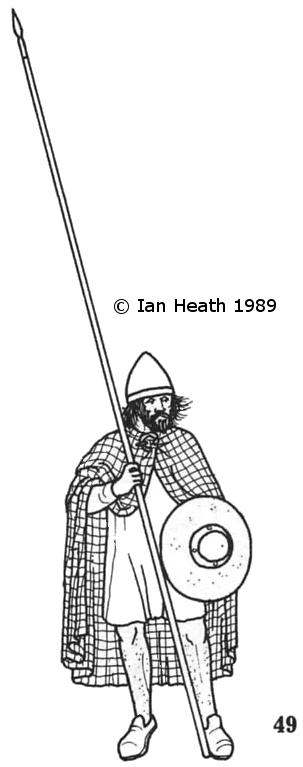
Register a SNAP EBT card with Amazon

SCOTS SPEARMAN, 12th-13th CENTURIES
An extract from Armies of Feudal Europe 1066-1300by Ian Heath


49. SCOTS SPEARMAN, 12th-13th CENTURIES
Poorly-armed infantry such as this constituted the bulk of most Scots armies throughout this era. Dress consisted chiefly of short tunic and cloak, though many were much more scantily clad; the Galwegians at the Battle of the Standard in 1138 wore tunics that left their buttocks only half-covered, while the levy of Angus is described by one chronicler in 1173 as composed of more than 3,000 men 'more naked than I can well say'. Scottish soldiers were characteristically barelegged and often barefoot. The saffron shirt of later centuries may have been becoming common by the end of the 13th century, though it was generally an upper-class garment, while tartan (from the Anglo-French tiretaine) was at this date merely brightly coloured woollen cloth; in Gaelic it was called breacan, which means spotted, striped or patterned.
The main weapon of the Scots infantryman was a long spear, probably about 12 feet in length and possibly longer (a Scottish parliament of 1318 called for the use of 16-foot spears, in such a way that it could be inferred the idea was not a new one). As early as the Battle of the Standard the 'naked' (ie, unarmoured) Scots are described as carrying 'lances of extraordinary length', and their use in the famous Scottish battle formation, the schiltron, is well-known. The shield, which gave its name to the schiltron, was probably fairly small. Those carried at the Standard are described as 'targes' of 'barkened [tanned] bull's hide'. Heater shields were also in use by the 13th century at the latest.
Other weapons in use were javelins, axe, knife and bow; a description of the Scots infantry at Largs in 1263 speaks of them as 'poorly armoured' and armed mainly with 'bows and Irish axes'. The axe was fairly popular, in fact, as was the gisarme, specified as the regulation weapon - along with a bow and arrows - for all those with less than 40s. worth of land in a statute of King William the Lion's reign (1165-1214). The bow, however, never became overwhelmingly popular, despite frequent recommendation in various 12th-14th century statutes. The best archers available to the Scots appear to have been Highlanders and Ettrick forest men.